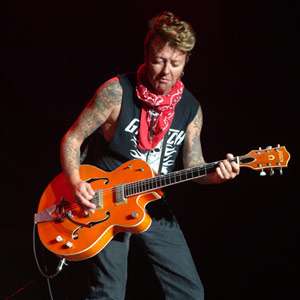
Gretsch 6120 Nashville

Brian Setzer
Gretsch 6120DC Nashville Double
Cutaway in Orange Stain, Hollow Body Guitar with Double Cutaway, Arched Laminated
Maple top, 3-Piece Maple/Walnut/Maple neck, TV Jones Classic Pickups, 3-Position
Toggle Master Tone Switch, Ebony fretboard, Ebony-Based Chrome Rocking Bar Bridge,
Gretsch Bigsby¨ B6G Vibrato Tailpiece, Polished Aluminum, Chrome and Gold-Plated
hardware, Gloss Urethane finish, Lever Activated String Mute, Snap-On Back Pad,
Neo Classic "Thumbnail" Inlay Position Markers, Zero Fret, Curly Maple
Headstock Overlay, Inlaid Pearloid Horseshoe and Gretsch Logo on Headstock,
Bound Fingerboard and Headstock, Multiple Body Bindings, Simulated F-Holes,
Aluminum Bigsby Paired with Gold-PLated Hardware, Gold Plexi Pickguard, Knurled
Strap Retainer Knobs, Deluxe Hardshell Case
Gretsch Nashville 6120 DC, New, Western Orange
Gretsch 6120 Nashville
The Gretsch 6120 debuted in 1954 as an instant classic. To many players, it is the definitive Gretsch.
When introduced, the 6120 cost $385 and sported a wagonload of western decorations: cow's heads and cactus etchings in the block markers, a big G brand on the top and more. It was the first in the "Chet Atkins" line of signature Gretsch guitars.
In '58, the half- moon or "neo classic" markers common to most Gretsches were introduced. The DeArmond pickups were discontinued in favor of Gretsch's own "FilterTron" humbuckers. Chet Atkins said the magnets on the DeArmond's were too strong, "sucked the tone right out of the guitar", and Duane Eddy was the only person he knew who got a good tone out of them.
In 1961, the body was narrowed from almost three inches thick to about two. This was to be the last year of the classic single- cutaway 6120.
The fake f- hole, thinline, double cutaway Electrotone body guitar of '62 was a completely different beast than previous 6120s. The price was up to $495, which bought you the all-new body, complete with a padded back, which conveniently hid the big access hole in the back. The signpost disappeared after '62, but a standby switch and muffler appeared, so if a guitarist got bored without anything to look at, he could always twiddle his knobs.
Some confusion exists over the difference between a Nashville and Chet Atkins 6120. In a nutshell, there ain't any. The Nashville name was arbitrarily stuck on the guitar, sometime around 1964. There's no difference between the guitars. It's just a name, but it came in handy (and continues to) when Atkins pulled his endorsement. The "Nashville" moniker was pretty much standard (or at least as standard as anything ever was at Gretsch) by 1964, and it could be found on the new shiny metal headstock plate. Some 6120s also got plain plastic HiLoTron covers in 1964. There may have been a shortage of FilterTron covers.
Like most Gretsches, 6120s began changing dramatically after the Baldwin Piano and Organ company took over Gretsch in '67, and the '67 model was just about the last to have the traditional Gretsch features.
By '70 the 6120 was wearing the squared-off pickguard common to the Baldwin era. In 1972, the model designation was changed to 7660.
Basic Nashville specs:
Body Material
Maple
Scale
24½"
Binding
White/black/white on body, neck and headstock
1964 Specs:
1964:
For 1964 the 6120 Chet Atkins changed its name to the 6120 Nashville. With the
change came a aquare metal plate on the headstock that read "Nashville"
(and covered and replaced the horseshoe that had been there), and of course,
a revamped pickguard. Padding on the back of the Electrotone body changed from
cloth or leather to vinyl. Note that for a brief period in 1964 Gretsch put
HiLoTron pickup surrounds around FilterTron pickups on the 6120.
Body Width
15½"
Body Depth
2"
Body Style
Double Cutaway Hollowbody
Colors
Sunset Orange
Fretboard Wood
Rosewood
Fretboard Markers
Neo-Classic
Nut
Zero Fret/Bone
Tuners
Waverly
Neck Pickup
"Patent Number" FilterTron
Bridge Pickup
"Patent Number" FilterTron
Controls
Master Volume
Neck pickup volume
Bridge pickup volume
Pickup selector switch
Tone Switch
Standby Switch
String Mute
Bridge
Bar
Tailpiece
Bigsby B-6 (V-cutout)